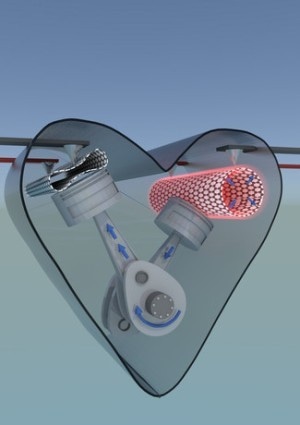Oct 14 2016
 Schematic drawing of two carbon nanotubes, one in inflated state (cylindrical tube to the right) and one in collapsed state (flattened tube to the left). The transition between the two states can be controlled by applying a small voltage which charges the tube electrostatically and thereby changes the state from a collapsed state to an inflated. The applied voltage is visualized by two tip contacts touching each tube. In the image the tubes are connected to two pistons to envision that the phase change of the tubes could set an imaginary nanomachine in motion. (Credit: Umeå University)
Schematic drawing of two carbon nanotubes, one in inflated state (cylindrical tube to the right) and one in collapsed state (flattened tube to the left). The transition between the two states can be controlled by applying a small voltage which charges the tube electrostatically and thereby changes the state from a collapsed state to an inflated. The applied voltage is visualized by two tip contacts touching each tube. In the image the tubes are connected to two pistons to envision that the phase change of the tubes could set an imaginary nanomachine in motion. (Credit: Umeå University)
Molecular-sized machines could be used to manipulate significant bodily mechanisms in the future. In a recent study, scientists from Umeå University and the University of California, Berkeley have electrostatically controlled a nanoballoon consisting of a carbon molecule 10,000 times thinner than a strand of human hair, to switch between collapsed and inflated state.
Inflatable balloon actuators are often used for microscopic applications, as impact protection in cars, to lift buildings or to widen narrowed or obstructed veins or arteries. In nature, spiders use micro-format fluid-filled cushions to push their legs in explosive jumps, and these nanoballoons are used as micro pumps at the micro scale.
Balloon actuators are virtually unknown in the nanoscale. However, a few years ago scientists from Penn State University theoretically suggested a charge controlled nanoballoon actuator based on the inflation and collapsing of carbon nanotubes.
This has been realized on an experimental level recently by Hamid Reza Barzegar and his team. In a paper reported recently in Nano Letters, the researchers have demonstrated how a carbon nanotube, which is a cylindrical tube made of carbon atoms, can be manipulated to switch from an inflated to a collapsed state and vice versa when a small voltage is applied.
The carbon nanotubes are defect-free, ensuring that an actuator can operate without fatigue or wear. The scientists also demonstrate this by running the actuator over multiple cycles, with no signs of decline in performance.
The work is conceptually interesting and gives insight into the complexity of how to control motion at the nanoscale by external stimuli. It also gives insight into fundamental physics such as how the capacitance effect and in general the electrostatic forces can be used to control the dynamics of molecular structures.
Hamid Reza Barzegar, Doctor of Physics, Umeå University
“In a longer perspective one can also envision how our findings could be used for pneumatic control on molecular level or for designing molecular containers that can open or close by controlling the surface charges of the molecules, by for example tuning the pH of the solution in which the molecules are dispersed. This could for example be of use for medical applications such as for delivering medicine to internal organs or tumors” says Thomas Wågberg, associate professor of Physics at Umeå University.
The discovery of molecular machines won the Nobel Prize in Chemistry for the year 2016. The prize was awarded to Jean-Pierre Sauvage, Fraser Stoddart and Bernard L Feringa for developing molecules with controllable movements that can accomplish a task when energy is applied.